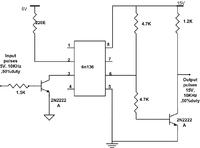sabu31
Advanced Member level 1
I have an optocoupler board as shown in figure . Though the circuit is working fine in simulation. I actual hardware theres is some wiring error which unable to debug. I am finding that the output is having pulses of peak 7.5V instead of 15V. When no pulses are given to the board, the ouput is 7.5V. What could be the reason. Thanking you.



